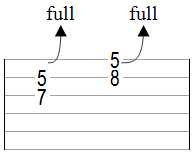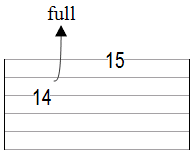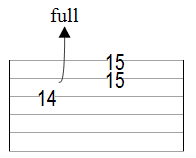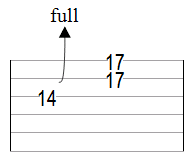Emotion To Any Guitar Lick

EMAIL TO GET ACCESS
By submitting your info, you agree to send it to Tom Hess Music Corporation who will process and use it according to their privacy policy.
 Hear The Classic Blues Guitar Double Stop
Hear The Classic Blues Guitar Double Stop
Although these blues guitar double stop licks sound cool, there are several problems guitarists run into when applying them into their playing:
1. The standard shapes such as the ones above have been used in countless lead guitar solos (so playing them too often sounds just like every blues guitar player).
2. Most guitarists think that ‘playing a blues guitar double stop’ equals playing one of the shapes above and never think about other ways this concept might be applied in blues. There are A LOT of options for using a blues guitar double stop creatively in your guitar playing.
3. The very cool tension and dissonance that begins the traditional blues guitar double stop is quickly resolved as both notes ring in unison after the double stop bend is complete. Because of this, the conventional blues double stop lacks the maximum intensity and aggression that it could have (more on this below).
Emotion To Any Guitar Lick

EMAIL TO GET ACCESS
By submitting your info, you agree to send it to Tom Hess Music Corporation who will process and use it according to their privacy policy.
Now that you’ve seen and heard the demonstration of the blues guitar double stop ideas in the video above, here is a detailed explanation of the elements that make these blues guitar licks sound so mean and aggressive:
Killer Blues Guitar Double Stop Element #1: Using different notes
The conventional blues guitar double stop (demonstrated at the start of the article) is basically an ornament of the same note. A much cooler way to play double stops is to use different notes from the scale, like this for example:
First you bend one of the notes on the G string and then play a different note on either the 2nd string or the 1st string, creating a double stop. Playing ‘different’ notes together helps to build more tension and make your double stops more aggressive.
In the first example above, you can let the open B string ring out because that note is part of the scale. However, for playing in other keys you would need to mute the B string using your fretting hand index finger while you strum the G string and the high E string. Learn how to do this by reading this article about muting unwanted guitar string noise.
 Strengthen Your Guitar Technique
Strengthen Your Guitar TechniqueDiscover how to play with cleaner,
more accurate guitar technique.
 How To Quickly Build Guitar Speed
How To Quickly Build Guitar SpeedLearn the secrets to building guitar speed by watching this free video.
 How To Fix Sloppy Guitar Playing
How To Fix Sloppy Guitar PlayingUse this muting technique to clean up your guitar playing right away.
Killer Blues Guitar Double Stop Element #2: Unexpected and prolonged dissonance
A typical blues double stop begins with a dissonant clash between notes a whole step apart and then resolves as the lowest note is bent up to sound the same pitch as the higher note (a ‘unison’). The licks I demonstrated for you in the video above follow the opposite pattern: first, a regular note is played from a scale that sounds normal and stable. Then, a clashing dissonant note from the scale is played together with it creating a double stop. This dissonance never resolves fully (until you stop playing). All of this makes the dissonance a lot more pronounced and builds A LOT more musical tension.
Killer Blues Guitar Double Stop Element #3: Double stop vibrato
Guitarists typically only think of adding vibrato to a single pitch when playing licks and melodies. However you can easily add vibrato to both notes of your double stop. When you do, it will sound a whole lot more intense. Compare the 2 recordings of the example below: you will first hear the double stop played WITHOUT vibrato and then again WITH vibrato on both notes:
 Hear A Blues Guitar Bend With And Without Vibrato
Hear A Blues Guitar Bend With And Without Vibrato
Note: To evenly apply vibrato to all notes of a double stop, you must develop a very controlled guitar vibrato technique, and/or use a floating bridge on your guitar or at least a standard whammy bar. Make sure to keep your vibrato in tune and mute any strings that are not being played to eliminate unwanted noise.
Get help with this by reading this article about playing clean and aggressive blues guitar licks.
Advanced Blues Guitar Double Stop Element: Adding even more notes/using a barre
You can further ornament your (already very mean sounding) blues double stop by playing more than 2 notes at the same time (as I illustrate in the video above at 0:44). A simple way to do this is to bend a note on the 3rd string in your blues scale and then play another pair of notes on strings 1 and 2. Here is an example:
 Hear A Blues Guitar Double Stop With A Barre
Hear A Blues Guitar Double Stop With A Barre
You can use your ring finger or pinkie finger to barre the 2 notes on the 15th fret in the example above. Here are 2 more examples of this:
To easily apply vibrato on guitar in these more advanced blues guitar double stop licks that use the barre and/or more than 2 notes, you need to have a floating bridge on your guitar that can be pushed back and forth with your picking hand (as I show in the video). However, don’t worry if your guitar doesn't have a floating bridge. You can still use the concepts from this article (including these more advanced blues guitar double stop variations) in your licks and solos.
Practice these double stop ideas in isolation first and then integrate them into your licks at the moments when you want to generate dissonance, tension and aggression.
By practicing these different variations you will quickly and seamlessly integrate blues guitar double stop licks into your solos. However, being able to play killer licks is only one aspect of being a great guitar player. Watch this to learn about the other elements of playing guitar with feeling.
Learn how to accelerate your guitar playing progress.
 | Forward this article to your friends |




